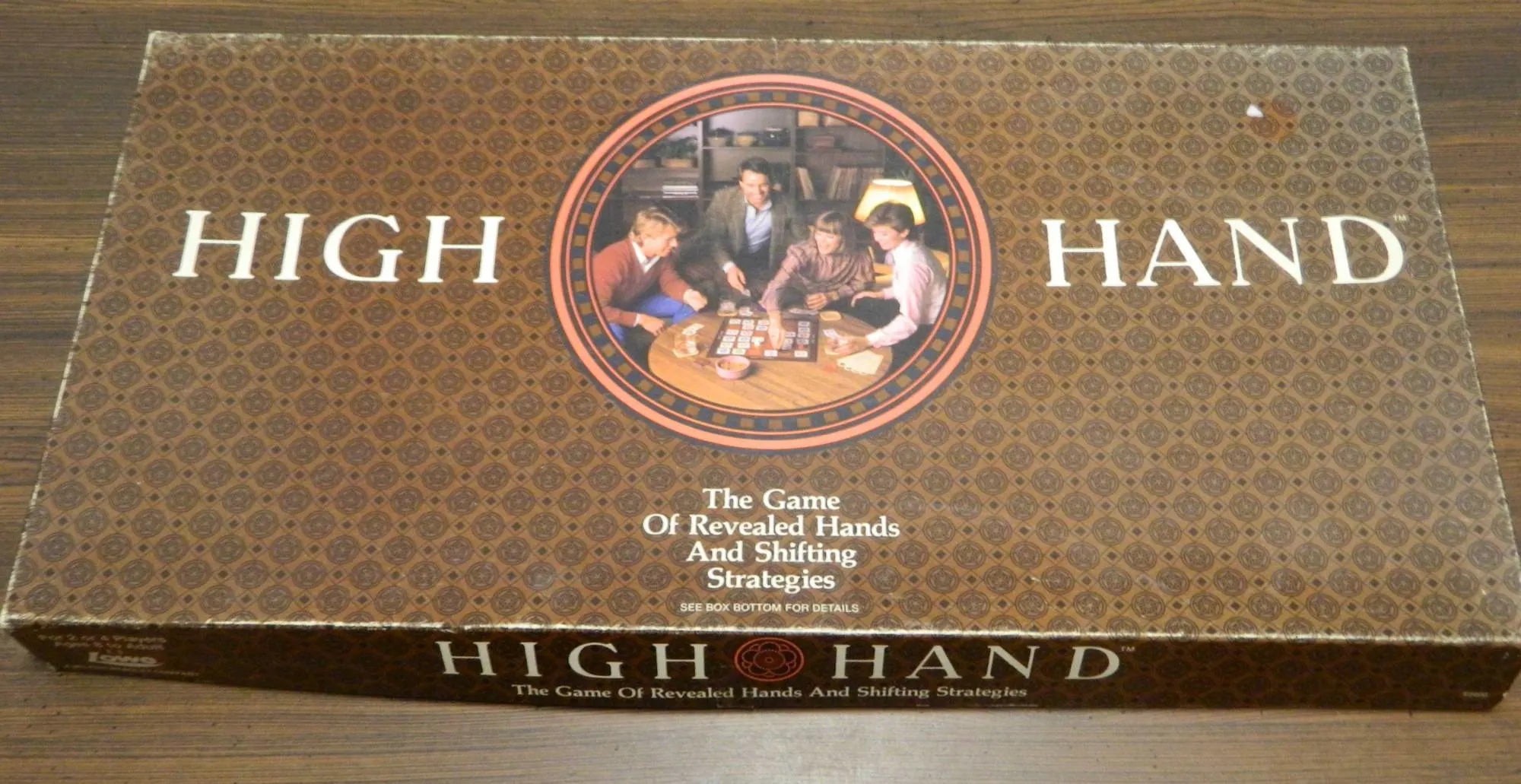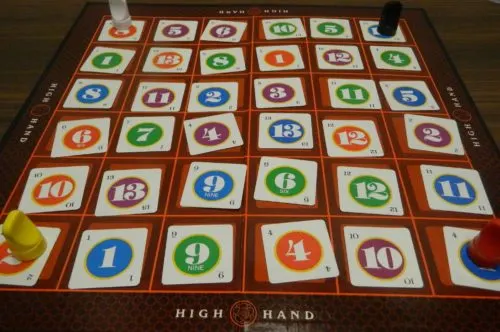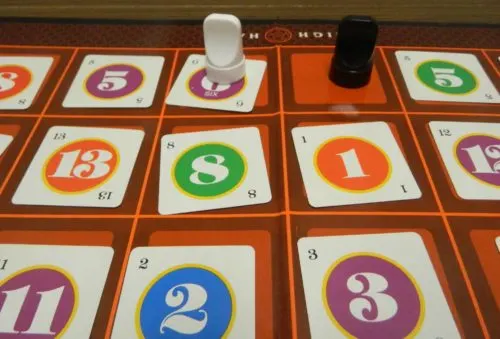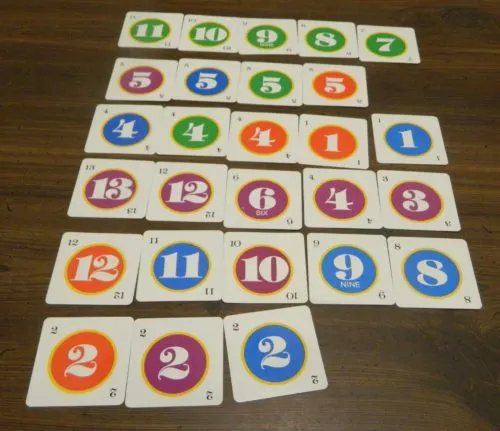With Poker being one of the most popular card games of all time there have been quite a few games that have tried to add their own twist on the formula. Most of these games either tweak the deck of cards or the scoring. Today’s game High Hand tweaks how you acquire cards by adding in a gameboard and an abstract strategy mechanic for movement. It even includes a partner mechanic. While the concept was kind of intriguing, the game’s boring box design left me with the feeling that it was going to be another really generic card game. High Hand can be summed up as Poker played on a gameboard but it actually succeeds at adding some interesting new ideas to Poker.
How to Play High Hand
Setup
- Place the gameboard in the middle of the table.
- Remove the two cards from the deck marked “Declaring Player” and “Declaring Player’s Partner”. Choose a dealer (rotates clockwise each round) who will shuffle the cards. The dealer will then randomly place the cards face up on the spots of the gameboard. The rest of the cards are set to the side of the gameboard.
- Each player chooses a color and places their playing piece in the corner space closest to them.
- Each player takes one of the prompt cards which shows the ranking of hands that you can acquire throughout the game.
- Each player chooses one of the unused cards. Whichever player draws the highest card will get to start the round. The cards drawn will then be placed back into the pile on the side of the board.
Playing the Game
A game of High Hand consists of five rounds. In each round players are trying to acquire cards to form their best hand.
On a player’s turn they will either move their pawn horizontally or vertically. They can move their pawn as many spaces as they want in their chosen direction. When a player stops on a space that has a card, the player takes the card and places it face up in front of them. If the player stops on a space without a card, their turn ends without them taking any cards.
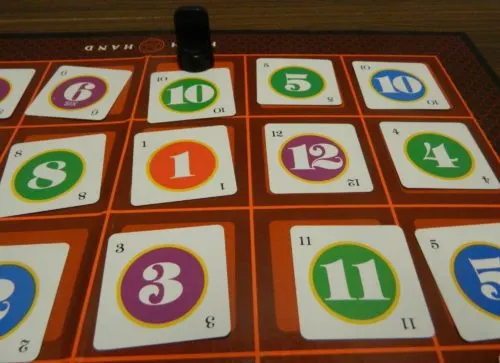
The black pawn has stopped on the green ten card. The player will take the card and place it face up in front of them.
While moving a player cannot move to a space occupied by another pawn or jump over another pawn. If a pawn is blocked in a way where it cannot move at all, the player loses their turn.
After moving their pawn, the next player clockwise takes their turn.
At any point in the game, a player can choose to pick their partner. If a player doesn’t think they are going to win a round they can choose to partner with the player they think will win the round. The player who chooses their partner is the “declaring player” and the player they choose as their partner is the “declaring player’s partner”. These players take the corresponding cards set aside during setup. For the rest of the round the declaring player should try to help their partner win the round. The other two players form the other team and work to help one another.
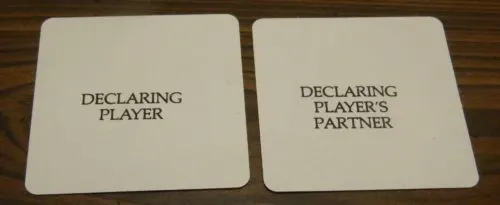
When a player picks their partner they will take the card on the left. They will give the card on the right to the player they chose as their partner.
End of Round
The round can end in one of two ways: one team concedes the round or all of the cards have been taken from the gameboard.
Each player chooses five of their cards to form their best hand. Partners can’t share their cards with their partner. The player who forms the highest ranked hand will win the round. The rank of the different hands are as follows along with the tiebreakers if two players have the same hand:
- Five consecutive cards of the same color – Tiebreaker: Whichever hand has the highest card.
- Four cards of the same number – Tiebreaker: Whichever hand’s set of four cards are higher.
- Three cards of one number and two cards of another number – Tiebreaker: Whichever hand’s trio of cards is higher.
- Five cards of the same color – Tiebreaker: Whichever hand has the highest card. If there is a tie for highest card, keep going to the next highest card until one of the hands have a higher card.
- Five consecutive cards of different colors – Tiebreaker: Whichever hand has the highest card.
- Three cards of the same number – Tiebreaker: Whichever hand has the higher trio of cards.
- Two cards of one number and two cards of another number – Tiebreaker: Whichever hand has the highest pair of cards.
- Two cards of one number – Tiebreaker: Whichever hand has the highest pair of cards.
Players will score points based on who had the highest ranked hand. If the declaring player had the highest ranked hand, no one scores any points. If the declaring player’s partner has the highest ranked hand, they will score 100 points while the declaring player will score 50 points. If a player on the non declared team wins the round, the player with the highest ranked hand gets 50 points while their partner gets 25 points.
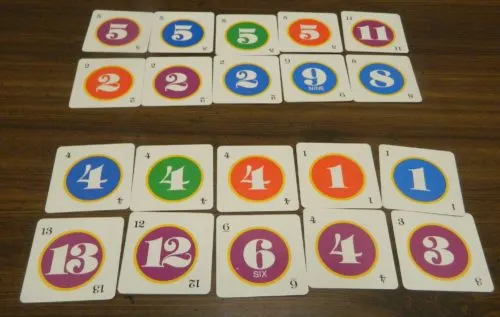
Of these four hands the top player had the highest ranked hand with four fives. If the top player was the declaring player’s partner, the top player would receive 100 points and the second player would receive 50 points. If the bottom pair was the declared pair, the top player would receive 50 points while the second player would receive 25 points.
If this wasn’t the fifth round, another round is played. The cards are reshuffled and placed on the gameboard. The teams are also reset so the players can form different teams in the next round.
End of Game
After five rounds have been played, the player who has scored the most points wins the game.
Two Player Games
For two player games you will follow all of the previous rules with the following additions:
- Each player will control two pawns which will start in the two corners on their side of the board.
- The players will alternate turns. The first pawn that a player moves will act as a blocking pawn. The player will not take the card that the pawn lands on. The second pawn that a player moves will be able to take the card from the space that it lands on.
- Whoever forms the highest ranked hand will score 100 points. The player who scores the most points after five rounds wins the game.
My Thoughts on High Hand
I began this review saying that High Hand is basically Poker with a gameboard mechanic added in. I made this comparison since High Hand is what you would get if you used a gameboard to choose your cards in Poker. As everyone has either played Poker or are at least familiar with the game, I am not going to really talk about that aspect of the game. You basically try to collect a group of cards of the same number, color or a straight. Instead of talking about Poker I want to talk about what is unique in High Hand.
By far the distinguishing mechanic in High Hand is the gameboard. Before each round all of the cards for the round are placed on a 6 x 6 grid. Each players’ pawn starts in one of the corners and players take turns moving around the board claiming the card that their pawn lands on. As players can move as many spaces as they want in one direction but can’t move through another player’s pawn, the gameboard adds an interesting abstract strategy mechanic to High Hand. As all of the cards for the round are placed face up on the table, players can decide what hand they are going to try to acquire before the round even starts. The goal is to find the most efficient path to acquire all of those cards while avoiding the other players’ pawns. It is unlikely that you will get all of the cards that you want though so you will have to be willing to change up your strategy whenever a player takes one of the cards that you want.
Before playing High Hand I thought it was going to be another very generic card game that was ultimately going to be pretty dull. I was actually pleasantly surprised by High Hand mostly due to the gameboard mechanics. While the mechanics are really simple they actually add a surprising amount to Poker. There is actually a decent amount of strategy in planning out your moves in order to get the cards you want before someone else takes them. In order to maximize each turn you need to plan ahead as you are able to move as many spaces as you want in one direction. If you know what cards other players want you can also make moves to get in their way preventing them from getting the cards they want. While High Hand is not a highly strategic game, it has more strategy than I expected.
Other than the board mechanics, the other unique thing about High Hand is the fact that it has a partnership mechanic if there are four players. Basically the partnership mechanic gives a player that isn’t going to win a round a chance to score some points by helping another player improve their hand. While the scoring portion of the partners mechanic has issues which I will get to shortly, adding a partnership mechanic to Poker is an interesting idea. The decision to basically forfeit the round and choose a partner is really important to your success in the game. You don’t want to make the decision too early where the player you choose doesn’t actually win but you also don’t want to wait too long and lose the partner you want. After partners are chosen the gameboard mechanics become more interesting. As two players are now working as a team, the two players can work together and use one player’s piece as a blocker to help their teammate get the cards that they need. This can actually add some interesting strategic decisions to the game.
At this point I am going to admit that we slightly misplayed High Hand when my group played the game. Our slight error was that when players took a card they kept them in their hand so the other players couldn’t see them. While we technically misplayed the game, I honestly think our error improved High Hand. If you play the game with your cards visible to all of the other players, everyone can see what you are trying to collect. If you start collecting a bunch of the same number or a bunch of cards in a row, the other players are going to notice pretty quickly. This should lead to players regularly stealing cards that other players need to complete their chosen hand. If a player forms a strong hand, someone will quickly claim them as their teammate. Playing by the official rules will lead to more of a defensive game as players prevent the other players from forming strong hands.
Not being able to see the other player’s cards makes the game more interesting in my opinion. The only knowledge you know about the other players’ hands is what you can remember them taking from the gameboard. This ends up adding an interesting memory mechanic to the game as you try to remember what the other players have. This allows players to get pretty strong hands if they can go about collecting the cards without letting the other players know. You can never be sure exactly how strong the other players’ hands are so you have to kind of estimate your current standing. This makes choosing a partner pretty interesting. You likely will want to wait to pick a partner until you know you have no chance of winning the hand. When choosing a partner you have to make an estimate of which player you think has the strongest hand. As this is all based on memory it is interesting when a player chooses a player that actually doesn’t have a strong hand. While it adds a little more thought to the game, I think forcing players to remember what the other players have collected is a nice addition to the game.
While I actually enjoyed High Hand considerably more than I expected, the game is far from perfect.
As I briefly mentioned earlier, I think the scoring system in High Hand has some issues. I actually don’t mind that players score a set number of points for either having the best hand or being their partner. This makes the scoring really simple as you don’t score a different amount of points for forming different types of hands. The problem is that I see no reason why a team should be punished just because they weren’t picked. A player shouldn’t score half as many points for having the best hand just because one of the players choose another player. You end up scoring just as many points picking the winning player than actually having the winning hand and not being chosen. There is no reason that the player with the best hand shouldn’t score 100 points while their partner scores 50 points. With how messed up the scoring system is, in the game I played one player was guaranteed at least a tie no matter what happened in the last round. They could just pick their partner at the beginning of the round which guaranteed that the most points any player could gain on them would be 50 points. Thus there was no reason to even play the last round.
The biggest problem with High Hand though is the fact that you don’t really even need the actual game. The game comes with the gameboard, 52 cards, and four playing pieces. The contents themselves are nothing special. They are kind of bland and feel a little cheap. The main reason why I say that you don’t really need the actual game is that you can easily make your own version with just a deck of standard playing cards and four pawns. A standard deck of playing cards will work fine as the face cards will stand in for the higher numbers from High Hand. If you want to create your own gameboard you just need to make a 6 x 6 grid large enough to fit the cards. You don’t really even need the gameboard as you can just lay the cards out in a 6 x 6 grid. Unless you can find High Hand for cheap, you can save money and space by just using a standard deck of playing cards.
The final issue with the game is that it just isn’t going to appeal to everyone. While I thought the gameboard mechanics were interesting, they aren’t enough if you don’t like Poker. You basically are playing Poker with the betting mechanics being replaced with a gameboard. As Poker is still a major portion of the game, I can’t see you enjoying High Hand if you don’t like Poker. At the same time if you mostly like poker for the betting mechanics, I also think High Hand might not be for you as they play no role in High Hand.
Should You Buy High Hand?
Before playing High Hand I expected it to be another very generic game where you tried to form the best Poker hand. While the Poker mechanics are far from original, High Hand actually surprised me. The mechanics involving the gameboard actually utilize a decent amount of strategy. You need to plan out your moves in advance to get all of the cards you want and you can also use your pawn to block the other players from getting the cards they want. The game also adds an interesting partner mechanic to Poker which allows players to work together in order to maximize one of the player’s hands. While High Hand surprised me, it is not going to appeal to people that don’t like Poker or the idea of adding a gameboard to Poker. The scoring could also use some work. Finally you could easily make your own version of the game with just a standard deck of playing cards and four pawns.
If you don’t like Poker or don’t think the gameboard mechanics sound that interesting, High Hand is probably not going to be for you. If the game’s premise sounds interesting to you though, I think you might be surprised by High Hand. Due to the fact that you could easily make your own version though, I would probably only recommend picking up High Hand if you can get a good deal on it.
If you would like to purchase High Hand you can find it online: Amazon, eBay

